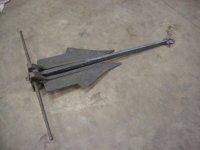Larry Patrick
New member
The 23 venture has a 25lb manson supreme. I will check archives also. I would like to have an emergency anchor ,if windlass got jammed or just to have a second anchor. Wife will be nervous to be anchoring overnight,not in a marina. I like the idea of being able to drop another anchor if ever need to. Will probably keep it in a milk crate ready to go. Would a 7lb fortress be good? Not sure where will be boating Lake erie, Cayuga ,Chesapeake,florida ect. What anchor grabs in most conditions,also can use it when backed into shore,like everyone does at lake powell. With a single motor feel like a second anchor should be on board. Thanks for ideas.


